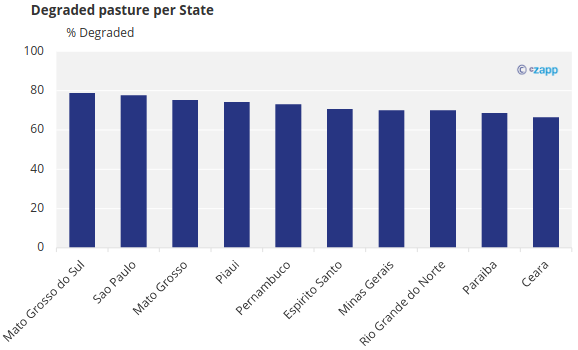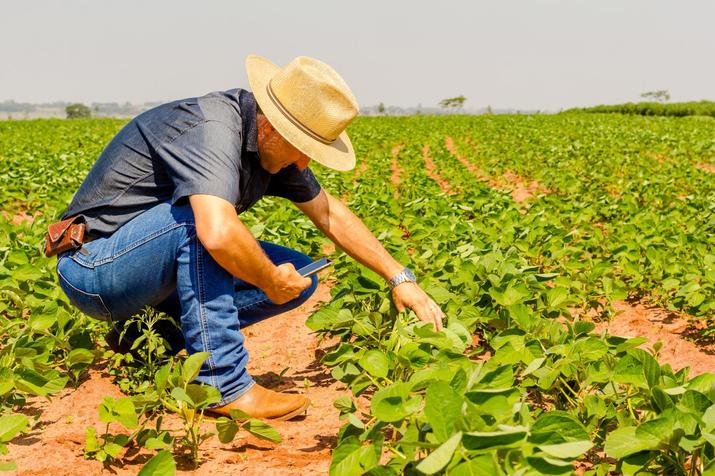Opinion Focus
- Recovery of degraded pastures helps to increase agricultural area without deforestation.
- Brazil recovered almost 21 million hectares of degraded pastures.
- Increased grain prices, greater access to credit and technological advances explain the trend.
Agricultural production is set to speed up: in the next 30 years, it will be necessary to feed 10 billion people, 30% more than currently, according to UN estimates. The question is how to guarantee food security in the world and, at the same time, preserve the environment. The answer may lie in solutions such as the recovery of degraded pastures, which can be converted to agriculture.

Soil recovery. Credit: iStock.
Soil degradation is more common than you think – and usually occurs due to factors such as inadequate soil management, excess weed plants and an increase in the area without vegetation cover, which can cause erosion and loss of nutrients.
The good news is that innovations such as the development of new seeds, suitable for various types of soil, in addition to technological advances in agricultural machinery and techniques such as direct planting (in which seeds are planted in undisturbed soil and the remains of vegetation from the surface area are maintained) have facilitated the conversion of pastures to agriculture.
In Brazil, it was possible to recover almost 21 million hectares of degraded pastures, out of a universe of around 120 million hectares, between 2000 and 2021, according to data from the Image Processing Laboratory (Lapig) at the Federal University of Goiás, which has been studying the subject.

Source: Lapig.
The academic world has been an ally in this process, with important advances in research into pasture recovery techniques. In recent years, Embrapa has developed everything from specific biological fertilizers for certain regions of the country, such as the Central-West, to pasture regeneration technologies for the North, where there is more humidity, and the land tends to become waterlogged.
One of the solutions already tested in the field, in Acre, is the inhibition of weed growth in damaged pastures through the application of two doses of herbicide at intervals of one month. Rural producers are also encouraged to use the direct planting technique. “In addition to a cost reduction of around 15% in the pasture recovery process, these techniques allow greater agility in soil regeneration”, says researcher Carlos Mauricio Andrade, from Embrapa, in an interview with Czapp.
The degree of complexity to regenerate the soil is directly related to the damage the area has suffered. There are different degrees of pasture degradation, which can range from the mildest, when it is only necessary to reinforce the fight against weeds in specific locations, to the most severe, with soil erosion and other problems that require more resources to overcome.

In Brazil, 38% of degraded pastures are at the so-called moderate level, with the presence of weeds on part of the land and an increase in bare soil, and 14% face more severe conditions.

Source: Lapig.
Pastures with a moderate level of degradation can be more easily converted into agricultural areas. The majority are concentrated in places such as the Mato Grosso do Sul. In the Cerrado, with 39% of pastures in a moderate degree of degradation, conversion to agricultural production has been closely observed by researchers, although there is still no official data on the matter.

“In the Central-West, we have seen many rural landowners converting degraded pastures into agricultural areas due to factors ranging from the appreciation of grain prices to the greater ease of obtaining credit based on sustainability criteria”, says Vinicius Vieira Mesquita, researcher at Lapig, who recently visited states such as Mato Grosso and Goiás to collect data on degraded pastures. A more complete study should be published next year.
Throughout Brazil, the pasture area increased by 80 million hectares between 1985 and 2022, reaching around 160 million hectares, with expansion concentrated until 2006. In the same period (between 1985 and 2022), the area destined for agriculture it grew by almost 42 million hectares, of which 21 million hectares are pastures that were converted for agricultural production.
The appreciation of agricultural commodities on the international market, such as soybeans, is cited as one of the main reasons for the conversion of degraded pastures into food growing areas. Between 2012 and 2022 alone, Brazilian producers received around 6% more (in values adjusted for inflation) per bag of soybeans, according to the Luiz de Queiroz College of Agriculture (Esalq), at the University of São Paulo.

Soy plantation. Credit: iStock.
The development of cultivars for biomes with more restricted levels of soil fertility, such as the Cerrado, also encouraged this movement. Innovations in the agribusiness production chain represent another important factor. “More modern machinery, capable of operating even on sloped land, normally used for pasture, is a good example of this trend”, explains Mesquita, from Lapig. As a result, agriculture is gaining new possibilities.
The growing concern with sustainability is highlighted as another essential element of efforts to regenerate soil. Stricter international trade rules, such as the new European law on importing food from areas with environmental liabilities, are already knocking on the door. At the same time, several ESG indicators, such as the recovery of soil health, are increasingly valued, pointing out paths for the future.








